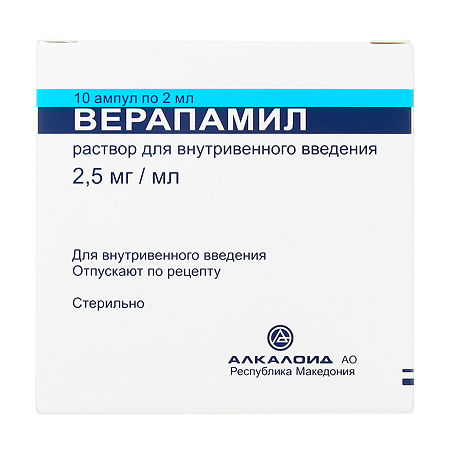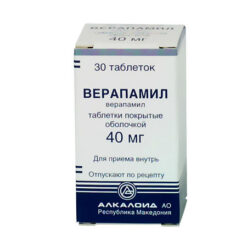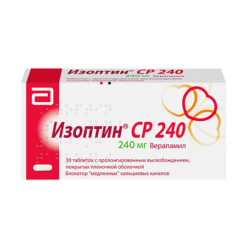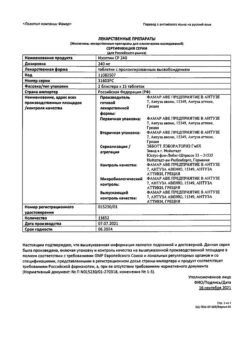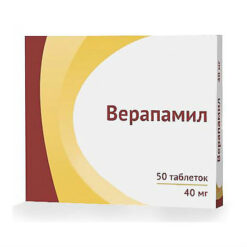No products in the cart.
Verapamil, 5 mg, 2 ml, 10 pcs.
€1.00
Out of stock
(E-mail when Stock is available)
Description
Pharmacodynamics
Verapamil has antianginal, hypotensive, antiarrhythmic effects.
Blocks calcium channels and decreases transmembrane calcium current. Reduces contractility, sinus node rhythm driver frequency and conduction velocity in AV node, sinoatrial and AV conduction, relaxes smooth muscles (arterioles more than veins), causes peripheral vasodilation, reduces total peripheral vascular resistance, reduces afterload. Increases myocardial perfusion, reduces imbalance between cardiac oxygen demand and supply, promotes regression of left ventricular hypertrophy, lowers blood pressure. It prevents the development and eliminates coronary artery spasm in variant angina pectoris. In patients with uncomplicated hypertrophic cardiomyopathy it improves blood outflow from the ventricles. It reduces the frequency and severity of headaches of vascular genesis.
The antiarrhythmic effect develops 1-5 minutes after intravenous administration, hemodynamic effects within 3-5 minutes.
Pharmacokinetics
In intravenous administration the half-life is biphasic: early – about 4 minutes, final – 2 – 5 hours. It is 90% bound to plasma proteins. Metabolized in the liver to form norverapamil, which has 20% of the hypotensive activity of verapamil, and 11 other metabolites (determined in trace amounts). Excreted mainly by the kidneys, partially – with the feces (16%). It penetrates into breast milk and passes through the placenta. In severe liver function disorders plasma clearance decreases by 70% and half-life increases to 14 – 16 hours.
Indications
Indications
Treatment of paroxysmal supraventricular tachycardia, ventricular flutter and fibrillation.
Active ingredient
Active ingredient
Composition
Composition
1 ml of solution for intravenous injection contains:
the active ingredient:
verapamil hydrochloride 2.5 mg
How to take, the dosage
How to take, the dosage
Verapamil is administered intravenously slowly (under control of blood pressure, electrocardiography, heart rate). To stop tachycardia attacks, 2 to 4 ml of 0.25% solution (5 to 10 mg of verapamil) is administered intravenously (for at least 2 minutes). If necessary, e.g. in paroxysmal tachycardia, another 5 mg may be administered 5-10 minutes later.
The single dose for children aged 1-15 years is 0.1 to 0.3 mg/kg (2-5 mg).
Elderly: The dose should be administered within 3 minutes to minimize the risk of side effects.
Dosing in hepatic and renal impairment: in hepatic and renal impairment, the effect of a single dose of the intravenously administered drug should not be increased, but the duration of action may be prolonged.
Interaction
Interaction
Enhances plasma levels of digoxin, cyclosporine, theophylline, carbamazepine, decreases – lithium. Weakens antibacterial activity of rifampicin, depressant effect of phenobarbital, decreases clearance of metoprolol and propranolol, increases the effect of muscle relaxants. Rifampicin, sulfinpyrazone, phenobarbital, calcium salts, vitamin D – weaken the effect.
Hypotensive effect is enhanced by antihypertensive drugs (diuretics, vasodilators), tricyclic and tetracyclic antidepressants and neuroleptics: antianginal – nitrates. Beta-adrenoblockers, class IA antiarrhythmics, cardiac glycosides, inhaled anesthetics, X-ray contrast agents potentiate (mutually) inhibitory effect on sinoatrial node automatism, AV conduction and myocardial contractility. If verapamil is used concomitantly with acetylsalicylic acid, the risk of bleeding increases. Cimetidine increases the plasma content of verapamil.
Verapamil may increase plasma concentrations of prazosin and terazosin, which may have an additive hypotensive effect, glibenclamide, buspirone and medazolam, atorvastatin, lovastatin and simvastatin.
Eritromycin, clarithromycin may increase the plasma concentration of verapamil.
Verapamil may increase the effects of colchicine, combined use is not recommended.
Special Instructions
Special Instructions
With caution, verapamil should be used in patients with significant liver dysfunction, in acute myocardial infarction, grade I atrioventricular blockade; in diseases with impaired neuromuscular transmission (myasthenia, Lambert-Eaton syndrome, Duchenne muscular dystrophy).
In patients with impaired left ventricular function, verapamil should be used only after heart failure has been managed with appropriate pharmacotherapy.
Contraindications
Contraindications
Side effects
Side effects
Cardiovascular system disorders: facial redness; marked bradycardia, atrioventricular blockade, arterial hypotension, occurrence of symptoms of heart failure are possible when administered in high doses, especially in predisposed patients. With rapid intravenous injection in single cases – complete transverse heart block, asystole, collapse.
Digestive system disorders: nausea, constipation; in single cases – transient increase of liver transaminase activity in plasma, reversible increase of alkaline phosphatase.
As to the central nervous system: dizziness, headache; rarely – nervousness, lethargy, increased fatigue, extrapyramidal syndrome.
Allergic reactions: skin rash, itching, bronchospasm, Stevens-Johnson syndrome.
Skin and subcutaneous tissue: erythema, hyperhidrosis.
When used for a long time – gynecomastia in men, gum hyperplasia, completely reversible after discontinuation of the drug.
Overdose
Overdose
Symptoms: bradycardia, atrioventricular-blockade, marked decrease of blood pressure, heart failure, shock, asystole, SA blockade.
Treatment: with rhythm and conduction disorders – intravenous isoprenaline, norepinephrine, atropine, 10 – 20 ml of 10% calcium gluconate solution, artificial pacemaker; intravenous infusion of plasma exchange solutions. Alpha-adrenergic stimulants (phenylephrine) are prescribed to increase blood pressure in patients with GOCMP; isoprenaline and norepinephrine should not be used. Hemodialysis is ineffective.
Calcium is a specific antidote (10-20 ml of 10% calcium gluconate solution intravenously), repeat the injection if necessary or administer by continuous infusion (e.g., 5mmol/hour).
Pregnancy use
Pregnancy use
The use of Verapamil during pregnancy is possible only when the expected benefit to the mother exceeds the potential risk to the fetus.
If it is necessary to use during lactation (breastfeeding), note that verapamil may be excreted with the breast milk.
Similarities
Similarities
Additional information
| Shelf life | 3 years. |
|---|---|
| Conditions of storage | In the dark place at a temperature not exceeding 25 ° C. |
| Manufacturer | Alkaloid AD Skopje, Republic of Northern Macedonia |
| Medication form | solution for infusion |
| Brand | Alkaloid AD Skopje |
Other forms…
Related products
Buy Verapamil, 5 mg, 2 ml, 10 pcs. with delivery to USA, UK, Europe and over 120 other countries.

